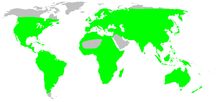Nursery web spider
| Nursery web spider | |
|---|---|
 | |
Nilus albocinctus, female Sabah, Borneo | |
Scientific classification | |
| Kingdom: | Animalia |
| Phylum: | Arthropoda |
| Subphylum: | Chelicerata |
| Class: | Arachnida |
| Order: | Araneae |
| Infraorder: | Araneomorphae |
| Family: | Pisauridae Simon, 1890[1] |
| Genera | |
See text. | |
Diversity[2] | |
47 genera, 355 species | |
 | |
Nursery web spiders are spiders of the family Pisauridae. They resemble wolf spiders (family Lycosidae), but they carry their egg sacs by means of their jaws and pedipalps (instead of attaching them to their spinnerets). When the eggs are about to hatch, a mother spider builds a nursery "tent", puts her egg sac inside, and mounts guard outside. The name "nursery web spider" is especially given to the European species Pisaura mirabilis, but the family also includes fishing spiders and raft spiders.
Unlike the wolf spiders, which have two very prominent eyes in addition to the other six, the eyes of the nursery web spiders are more or less the same size.[3] Many species are able to walk on the surface of still bodies of water, and may even dive beneath the surface for a time to escape enemies. In escaping predators, they may very well jump a distance of 5–6 inches. However, they do not find it easy to make their way up extremely smooth surfaces such as glass.
The female spider sometimes attempts to eat the male after mating. The male, to reduce the risk of this, often presents the female with a gift such as a fly when approaching in the hope that this will satisfy her hunger. Sometimes, this gift is a fake present intended to fool the female.[4] Males may wrap the fake gift in silk, to deceive the female to mate. Females can detect the fake gift and terminate mating, negating the male's deception in not giving a real gift.[5]
Contents
1 Taxonomy
1.1 Genera
2 See also
3 References
Taxonomy
Genera
As of March 2016[update], the World Spider Catalog accepted the following extant genera:[1]
Afropisaura Blandin, 1976
Archipirata Simon, 1898
Architis Simon, 1898
Bradystichus Simon, 1884
Caripetella Strand, 1928
Charminus Thorell, 1899
Chiasmopes Pavesi, 1883
Cispinilus Roewer, 1955
Cispius Simon, 1898
Cladycnis Simon, 1898
Conakrya Schmidt, 1956
Dendrolycosa Doleschall, 1859
Dolomedes Latreille, 1804
Eucamptopus Pocock, 1900
Euprosthenops Pocock, 1897
Euprosthenopsis Blandin, 1974
Hala Jocqué, 1994
Hygropoda Thorell, 1894
Ilipula Simon, 1903
Inola Davies, 1982
Maypacius Simon, 1898
Megadolomedes Davies & Raven, 1980
Nilus O. Pickard-Cambridge, 1876
Papakula Strand, 1911
Paracladycnis Blandin, 1979
Perenethis L. Koch, 1878
Phalaeops Roewer, 1955
Pisaura Simon, 1885
Pisaurina Simon, 1898
Polyboea Thorell, 1895
Qianlingula Zhang, Zhu & Song, 2004
Ransonia Blandin, 1979
Rothus Simon, 1898
Sphedanus Thorell, 1877
Stoliczka O. Pickard-Cambridge, 1885
Tallonia Simon, 1889
Tapinothele Simon, 1898
Tapinothelella Strand, 1909
Tapinothelops Roewer, 1955
Tetragonophthalma Karsch, 1878
Thalassiopsis Roewer, 1955
Thaumasia Perty, 1833
Tinus F. O. Pickard-Cambridge, 1901
Tolma Jocqué, 1994
Voraptipus Roewer, 1955
Vuattouxia Blandin, 1979pa
Walrencea Blandin, 1979
Some fossilized spiders have also been assigned to this family:[6]
†Eopisaurella Petrunkevitch, 1958 (Early Eocene; Baltic amber)- †Palaeoperenethis Seldon & Penney, 2009 (Ypresian, British Columbia, Canada)

Nursery web spider carrying egg sac

Dolomedes fimbriatus with its nursery of babies

Megadolomedes australianus with a dragonfly as prey
See also
- List of Pisauridae species
- Spider families
References
Wikispecies has information related to Pisauridae |
| Wikimedia Commons has media related to Pisauridae. |
^ ab "Family: Pisauridae Simon, 1890". World Spider Catalog. Natural History Museum Bern. Retrieved 2016-03-15..mw-parser-output cite.citationfont-style:inherit.mw-parser-output .citation qquotes:"""""""'""'".mw-parser-output .citation .cs1-lock-free abackground:url("//upload.wikimedia.org/wikipedia/commons/thumb/6/65/Lock-green.svg/9px-Lock-green.svg.png")no-repeat;background-position:right .1em center.mw-parser-output .citation .cs1-lock-limited a,.mw-parser-output .citation .cs1-lock-registration abackground:url("//upload.wikimedia.org/wikipedia/commons/thumb/d/d6/Lock-gray-alt-2.svg/9px-Lock-gray-alt-2.svg.png")no-repeat;background-position:right .1em center.mw-parser-output .citation .cs1-lock-subscription abackground:url("//upload.wikimedia.org/wikipedia/commons/thumb/a/aa/Lock-red-alt-2.svg/9px-Lock-red-alt-2.svg.png")no-repeat;background-position:right .1em center.mw-parser-output .cs1-subscription,.mw-parser-output .cs1-registrationcolor:#555.mw-parser-output .cs1-subscription span,.mw-parser-output .cs1-registration spanborder-bottom:1px dotted;cursor:help.mw-parser-output .cs1-ws-icon abackground:url("//upload.wikimedia.org/wikipedia/commons/thumb/4/4c/Wikisource-logo.svg/12px-Wikisource-logo.svg.png")no-repeat;background-position:right .1em center.mw-parser-output code.cs1-codecolor:inherit;background:inherit;border:inherit;padding:inherit.mw-parser-output .cs1-hidden-errordisplay:none;font-size:100%.mw-parser-output .cs1-visible-errorfont-size:100%.mw-parser-output .cs1-maintdisplay:none;color:#33aa33;margin-left:0.3em.mw-parser-output .cs1-subscription,.mw-parser-output .cs1-registration,.mw-parser-output .cs1-formatfont-size:95%.mw-parser-output .cs1-kern-left,.mw-parser-output .cs1-kern-wl-leftpadding-left:0.2em.mw-parser-output .cs1-kern-right,.mw-parser-output .cs1-kern-wl-rightpadding-right:0.2em
^ "Currently valid spider genera and species", World Spider Catalog, Natural History Museum Bern, retrieved 2016-03-15
^ Sierwald, P. (1997) Phylogenetic analysis of Pisaurine nursery web spiders, with revisions of Tetragonophthalma and Perenethis (Araneae, Lycosidae, Pisauridae). The Journal of Arachnology 25:361–407 Americanarachnology.org
^ Male Spiders Scam Females with Gift-Wrapped Garbage
^ Albo, Maria J; Winther, Gudrun; Tuni, Cristina; Toft, Søren; Bilde, Trine (2011-11-14). "Worthless donations: male deception and female counter play in a nuptial gift-giving spider". BMC Evolutionary Biology. 11 (1): 329. doi:10.1186/1471-2148-11-329. PMC 3228764. PMID 22082300.
^ Dunlop, J.A.; Penney, D.; Jekel, D. (2015). "A summary list of fossil spiders and their relatives" (PDF). World Spider Catalog. Natural History Museum Bern. Retrieved 2016-03-15.



